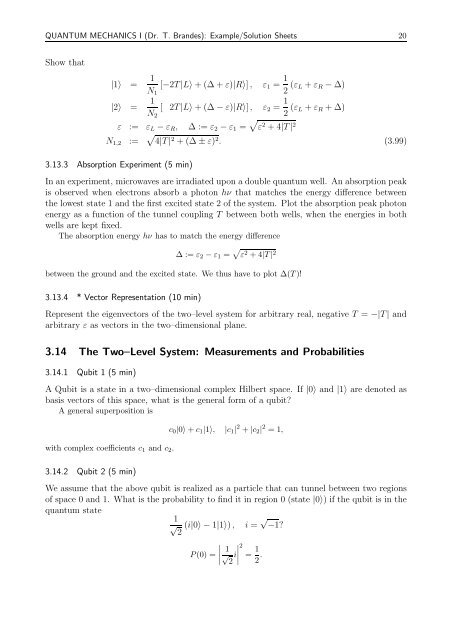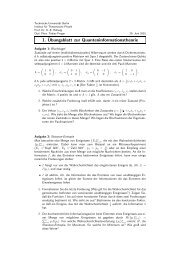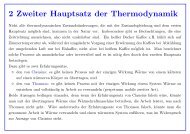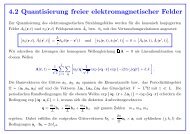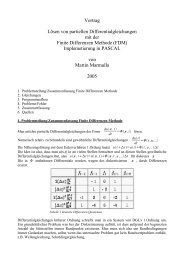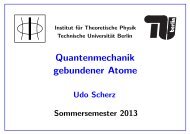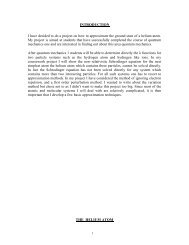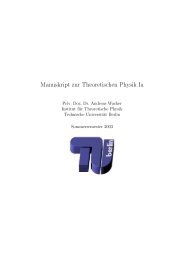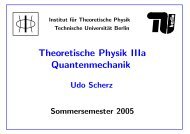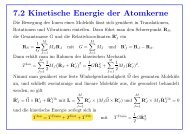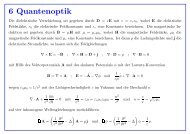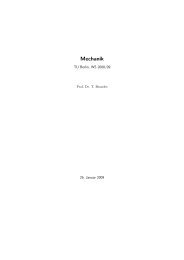1.1 The Radiation Laws and the Birth of Quantum Mechanics
1.1 The Radiation Laws and the Birth of Quantum Mechanics
1.1 The Radiation Laws and the Birth of Quantum Mechanics
You also want an ePaper? Increase the reach of your titles
YUMPU automatically turns print PDFs into web optimized ePapers that Google loves.
QUANTUM MECHANICS I (Dr. T. Br<strong>and</strong>es): Example/Solution Sheets 20<br />
Show that<br />
|1〉 = 1 N 1<br />
[−2T |L〉 + (∆ + ε)|R〉] , ε 1 = 1 2 (ε L + ε R − ∆)<br />
|2〉 = 1 N 2<br />
[ 2T |L〉 + (∆ − ε)|R〉] , ε 2 = 1 2 (ε L + ε R + ∆)<br />
ε := ε L − ε R , ∆ := ε 2 − ε 1 = √ ε 2 + 4|T | 2<br />
N 1,2 := √ 4|T | 2 + (∆ ± ε) 2 . (3.99)<br />
3.13.3 Absorption Experiment (5 min)<br />
In an experiment, microwaves are irradiated upon a double quantum well. An absorption peak<br />
is observed when electrons absorb a photon hν that matches <strong>the</strong> energy difference between<br />
<strong>the</strong> lowest state 1 <strong>and</strong> <strong>the</strong> first excited state 2 <strong>of</strong> <strong>the</strong> system. Plot <strong>the</strong> absorption peak photon<br />
energy as a function <strong>of</strong> <strong>the</strong> tunnel coupling T between both wells, when <strong>the</strong> energies in both<br />
wells are kept fixed.<br />
<strong>The</strong> absorption energy hν has to match <strong>the</strong> energy difference<br />
∆ := ε 2 − ε 1 = √ ε 2 + 4|T | 2<br />
between <strong>the</strong> ground <strong>and</strong> <strong>the</strong> excited state. We thus have to plot ∆(T )!<br />
3.13.4 * Vector Representation (10 min)<br />
Represent <strong>the</strong> eigenvectors <strong>of</strong> <strong>the</strong> two–level system for arbitrary real, negative T = −|T | <strong>and</strong><br />
arbitrary ε as vectors in <strong>the</strong> two–dimensional plane.<br />
3.14 <strong>The</strong> Two–Level System: Measurements <strong>and</strong> Probabilities<br />
3.14.1 Qubit 1 (5 min)<br />
A Qubit is a state in a two–dimensional complex Hilbert space. If |0〉 <strong>and</strong> |1〉 are denoted as<br />
basis vectors <strong>of</strong> this space, what is <strong>the</strong> general form <strong>of</strong> a qubit<br />
A general superposition is<br />
with complex coefficients c 1 <strong>and</strong> c 2 .<br />
3.14.2 Qubit 2 (5 min)<br />
c 0 |0〉 + c 1 |1〉, |c 1 | 2 + |c 2 | 2 = 1,<br />
We assume that <strong>the</strong> above qubit is realized as a particle that can tunnel between two regions<br />
<strong>of</strong> space 0 <strong>and</strong> 1. What is <strong>the</strong> probability to find it in region 0 (state |0〉) if <strong>the</strong> qubit is in <strong>the</strong><br />
quantum state<br />
1<br />
√<br />
2<br />
(i|0〉 − 1|1〉) , i = √ −1<br />
P (0) =<br />
1<br />
2<br />
∣√ i<br />
2<br />
∣ = 1 2 .


